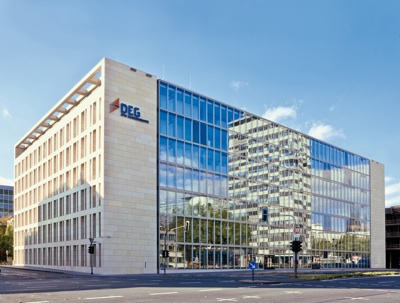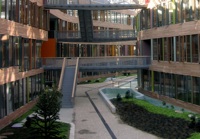
Features
Business intelligence
Contracting
Sustainable future for the construction industry
February 13, 2010 By Sebastian Pflugge
 Feb. 13, 2010 – Ongoing climate change, the limited availability of fossil fuels and far-reaching environmental protection laws are forcing the construction industry to set up sustainable development schemes that also include energy-efficient building products.
Feb. 13, 2010 – Ongoing climate change, the limited availability of fossil fuels and far-reaching environmental protection laws are forcing the construction industry to set up sustainable development schemes that also include energy-efficient building products.
Feb. 13, 2010 – Ongoing climate change, the limited availability of fossil fuels and far-reaching environmental protection laws are forcing the construction industry to set up sustainable development schemes that also include energy-efficient building products.
 |
|
| Eco-friendly – with plenty of glass: The new head office of DEG – the German Development and Investment Council – in Cologne received the golden German Quality Seal for Sustainable Buildings in June 2009. Photograph: DEG Studio: Werbung & Design GmbH.
|
The issue of sustainability is gaining substantially in significance in virtually all sectors of industry. This applies particularly to the building sector. According to reports from the World Business Council for Sustainable Development (WBCSD), the construction industry accounts for 40 per cent of energy consumption worldwide and is thus a major player. It contributes about 30 per cent to the release of harmful carbon dioxide (CO2) and produces an annual volume of 360 metric tonnes of waste, according to the German Sustainable Building Council (DGNB).
Although the concept of sustainability is used quite frequently, the ideas that accompany the associated requirements are still rather vague and often incomplete among many representatives of the construction industry. The sustainability that is demanded for architecture is not limited to detailed solutions, but requires a new, comprehensive approach to the planning of buildings.

|
| As well as being eco-friendly and energy- efficient, sustainable buildings also provi- de an attractive ambience. These newly built premises of the German Environment Ministry in Dessau with their large atrium are a good example. They were created on the basis of sustainability criteria, with an overall design that meets all the requirements on environmental, economic and socio-cultural dimensions. Photograph: Volkhard Möcker, UBA. |
Three dimensions of sustainability
Sustainability requirements can be broken down into three dimensions: economic, environmental and socio-cultural. The aim of economic sustainability is to protect economic resources. Where the building industry is concerned, it requires us to look not just at the cost of acquisition and construction, but also at the entire lifecycle of a building and at the cost of demolition.
The environmental dimension refers to the preservation of the environment from one generation to another. Here, sustainability in architecture means the conservation of resources through the optimised use of building materials and products, reducing the need for heating materials, electric power, water and the volume of waste water.
As for the socio-cultural dimension of sustainability, the catalogue of requirements can be summed up as focusing on the protection of human health, on safeguarding a viable community and on ensuring adequate comfort. Major components in architecture are, for instance, thermal insulation, lighting, soundproofing, barrier-free access, the selection of materials and aesthetic aspects.
These dimensions of sustainability can serve as the basis for formulating comprehensive and specific targets for buildings. The ideal way forward would be to analyse each stage in the lifetime of a building for the different aspects of sustainability and then to optimise interaction between those aspects. Having assessed, evaluated and considered the aspects arising from all three dimensions, the envisaged aim is to create highly functional high-quality buildings throughout their entire lifecycle, whilst minimising, where possible, any negative environmental impact that might occur.
Implementation in building design
In the building sector sustainability is demanded not only by governments, but increasingly also by owners and users. It means the development of new holistic concepts, with a demand for intelligent technologies, new construction methods, environmentally safe building materials and the eco-friendly use of energy. In view of increasingly difficult conditions as a result of climate change and more expensive fossil fuels, these are the criteria that are becoming more and more central for architects, planners and owners, both in the construction of buildings and in their modernisation. The technologies and products that are required for the implementation of new principles are largely available. One obstacle, however, is quite often the lack of practical experience with sustainable construction principles and with standardised evaluation methods for the sustainability of components such as windows, doors and façades. The industry rejects as too broad any classification that is merely based on the much quoted product carbon footprint (PCF), which only looks at the CO2 output caused by a product. However, the EU Commission has already announced that it wants to set up a European quality seal for all products where their use impacts energy consumption.
Although sustainable construction involves considerably more resources in planning and implementation and thus also higher costs, industry experts are expecting to see a clear rise in demand for suitable high-quality properties on the part of owners and investors. The reasons are obvious: Buildings with a proven level of sustainability are economically efficient and eco-friendly while also saving resources, both in the medium and long term. This makes them easier to sell or let, while operating costs are manageable. Other important factors remain the sustained value of a building, its optimum integration into its socio-cultural setting and thus ultimately the feel-good factor of its users.
Establishment of quality seals
To encourage sustainable construction and to present high-quality buildings to the general public, many countries already have their own quality seals. One internationally recognised certificate, for instance is the German Certificate for Sustainable Buildings, awarded jointly by the German Sustainable Building Council (DGNB) and the German Ministry of Transport, Building and Urban Development. The far-reaching specifications of the quality seal allow a comprehensive assessment of the environmental, economic and socio-cultural qualities of a building throughout its entire lifecycle.
At the European level, the voluntary GreenBuilding Programme of the EU Commission has become established as a way to encourage sustainable principles for the improvement of energy efficiency and the use of renewable energies in non-residential areas.
Demand for greater energy efficiency
One fundamental component of the sustainability principle in the construction industry is the energy efficiency of the products and technologies that are in use and of a building as a whole. This also applies against the background of current and future legal specifications for energy savings. In Europe, for instance, potential energy savings for buildings are to be developed in a new version of the EU Directive on the Energy Performance of Buildings (2002/91/EC). The directive, due to come into force in spring 2010, specifies among other things that all new buildings must be "nearly zero energy buildings" from 2021 onwards. For public buildings this requirement will become applicable two years earlier. "Nearly zero energy buildings" have a very high level of overall energy efficiency and largely cover their small remaining need for energy from renewables sources.
The fulfilment of high energy requirements makes it indispensable to use innovative, energy-efficient building products. This applies especially to windows and façades. Their performance largely depends on highly functional glass products which deliver highly efficient heat insulation, channelling light into the depth of the room where required, while also ensuring adequate shade and reliable soundproofing. Moreover, as they form part of a photovoltaic and solar heating system, they also generate eco-friendly energy.
Sustainable construction solutions
glasstec 2010 in Düsseldorf will be showing the progress of developments in this supplier sector which is so important for the architecture of the future. This internationally important glass trade fair will be held from 28 September to 1 October, with product solutions for sustainable buildings being presented by exhibitors from all over the world. As before, one particularly far-reaching glimpse into the future of glass will be given by the special exhibition "glass technology live". This year's motto, called "Energy Efficiency with Glass" promises innovative products and systems for sustainable buildings and other applications. For the first time this year, the trade fair will include a Façade Centre that will revolve entirely around the façade architecture of the future.
Print this page
Leave a Reply